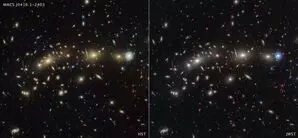
Most colourful image of universe created by Webb, Hubble
text_fieldsWashington: Using visible and infrared light, the powerful Hubble and James Webb space telescopes have combined to produce one of the most complete images of the universe ever captured.
The image centres on the massive galaxy cluster MACS0416, which is situated approximately 4.3 billion light-years away from Earth.
MACS0416 is a pair of colliding galaxy clusters that will eventually combine to form an even bigger cluster.
The image includes a bounty of galaxies outside the cluster and a sprinkling of sources that vary over time, likely due to gravitational lensing -- the distortion and amplification of light from distant background sources.
This cluster was the first of a set of unprecedented, super-deep views of the universe from an ambitious, collaborative Hubble programme called the Frontier Fields, inaugurated in 2014.
Webb's infrared view significantly bolsters this deep look by going even farther into the early universe with its infrared vision.
"We are building on Hubble's legacy by pushing to greater distances and fainter objects," said Rogier Windhorst of Arizona State University, principal investigator of the PEARLS programme (Prime Extragalactic Areas for Reionization and Lensing Science), which took the Webb observations.
The findings are detailed in two research papers: one published in Astronomy & Astrophysics, and another accepted for publication in The Astrophysical Journal. Besides contributing to aesthetic view, the images also reveal a specific scientific purpose, that is to search for objects varying in observed brightness over time, known as transients. The team combined their three epochs of observations, each taken weeks apart, with a fourth epoch from the CANUCS (CAnadian NIRISS Unbiased Cluster Survey) research team.
They identified 14 such transients across the field of view. Twelve of those transients were located in three galaxies that are highly magnified by gravitational lensing, and are likely to be individual stars or multiple-star systems that are briefly very highly magnified.
The remaining two transients are within more moderately magnified background galaxies and are likely to be supernovae.
"We're calling MACS0416 the Christmas Tree Galaxy Cluster both because it's so colourful and because of these flickering lights we find within it. We can see transients everywhere," said Haojing Yan of the University of Missouri in Columbia, lead author of one paper describing the scientific results.
Webb is an international programme led by NASA with its partners, ESA (European Space Agency) and the Canadian Space Agency. Hubble is managed by both NASA and ESA.
With inputs from IANS























